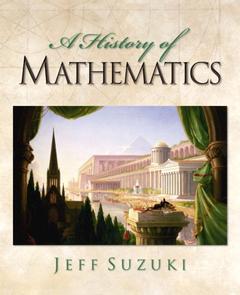Description
A history of mathematics
Author: SUZUKI Jeff
Language: English
Approximative price 104.84 €
Subject to availability at the publisher.
Add to cart
Publication date: 01-2002
832 p. · 23.5x17.8 cm · Hardback
832 p. · 23.5x17.8 cm · Hardback
Description
/li>Contents
/li>Comment
/li>
Blending relevant mathematics and history, this book immerses readers in the full, rich detail of mathematics. It provides a description of mathematics and shows how mathematics was actually practiced throughout the millennia by past civilizations and great mathematicians alike. As a result, readers gain a better understanding of why mathematics developed the way it did. KEY TOPICS: Chapter topics include Egyptian Mathematics, Babylonian Mathematics, Greek Arithmetic, Pre-Euclidean Geometry, Euclid, Archimedes and Apollonius, Roman Era, China and India, The Arab World, Medieval Europe, Renaissance, The Era of Descartes and Fermat, The Era of Newton and Leibniz, Probability and Statistics, Analysis, Algebra, Number Theory, the Revolutionary Era, The Age of Gauss, Analysis to Mid-Century, Geometry, Analysis After Mid-Century, Algebras, and the Twentieth Century. MARKET: For teachers of mathematics.
1. Egyptian Mathematics.
2. Babylonian Mathematics.
3. Greek Arithmetic.
4. Pre-Euclidean Geometry.
5. Euclid.
6. Archimedes and Apollonius.
7. Roman Era.
8. China and India.
9. The Arab World.
10. Medieval Europe.
11. Renaissance.
12. The Era of Descartes and Fermat.
13. The Era of Newton and Leibniz.
14. Probability and Statistics.
15. Analysis.
16. Algebra.
17. Number Theory.
18. The Revolutionary Era.
19. The Age of Gauss.
20. Analysis to Mid-Century.
21. Geometry.
22. Analysis After Mid-Century.
23. Algebras.
24. The Twentieth Century.
Appendix A: Answers to Selected Exercises.
Appendix B: Select Bibliography.
2. Babylonian Mathematics.
3. Greek Arithmetic.
4. Pre-Euclidean Geometry.
5. Euclid.
6. Archimedes and Apollonius.
7. Roman Era.
8. China and India.
9. The Arab World.
10. Medieval Europe.
11. Renaissance.
12. The Era of Descartes and Fermat.
13. The Era of Newton and Leibniz.
14. Probability and Statistics.
15. Analysis.
16. Algebra.
17. Number Theory.
18. The Revolutionary Era.
19. The Age of Gauss.
20. Analysis to Mid-Century.
21. Geometry.
22. Analysis After Mid-Century.
23. Algebras.
24. The Twentieth Century.
Appendix A: Answers to Selected Exercises.
Appendix B: Select Bibliography.
- Complete treatment of mathematics of the past Not just a description of the mathematics.
- Allows for a better understanding of the evolution of mathematics.
- Reliance on original source material.
- Gives the student insight into how mathematicians of the past approached mathematics.
- Exercises, stated and solved using period methods.
- Encourages students to think as the mathematicians of the past and gives instructors a wider variety of techniques to use in the classroom.
- Emphasizes the impact of secular history on mathematics.
- Shows students how mathematicians and the development of mathematics are affected by world events.
- The importance of history in teaching is emphasized.
© 2024 LAVOISIER S.A.S.
These books may interest you

SpaceA History 32.23 €



